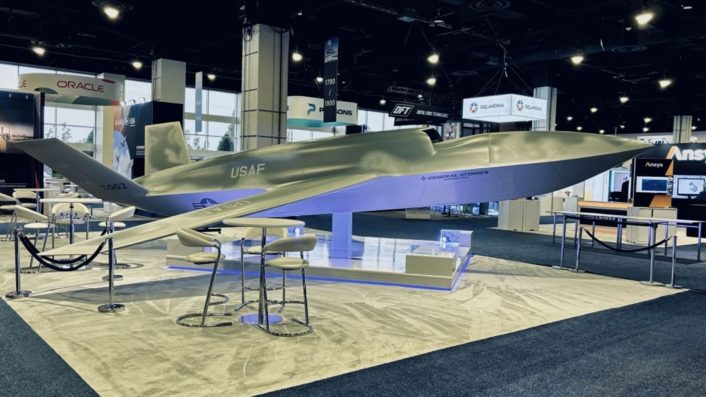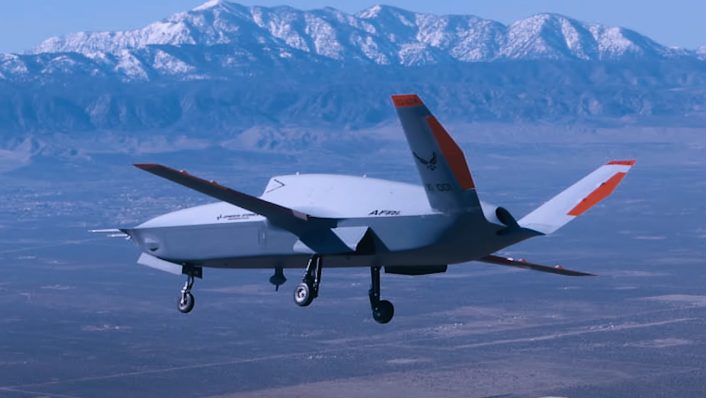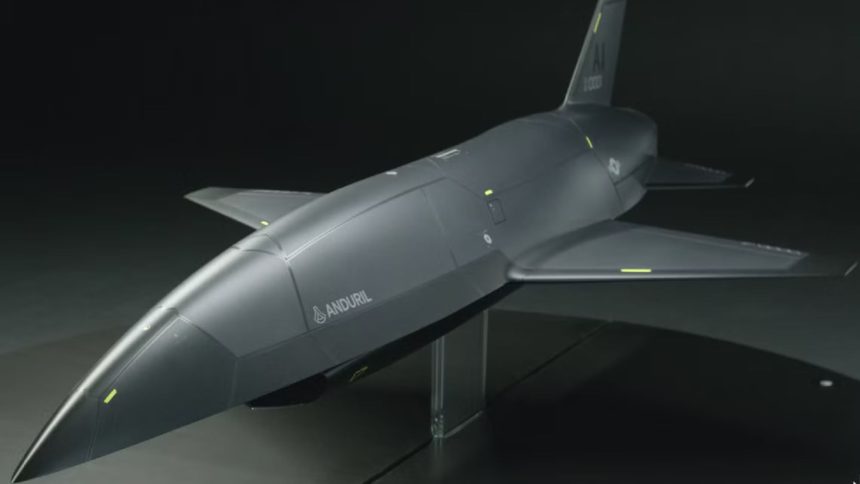Air Force Materiel Command’s Col. Timothy M. Helfrich broke down what might constitute the Increment 1 and Increment 2 of the CCAs, describing how the service is changing the procurement of the unmanned assets to meet costs and schedule while adapting to emerging technologies and threats.
The AFMC (Air Force Material Command) revealed on Nov. 13, 2024, that two CCA (Collaborative Combat Aircraft) – one each from Anduril Industries and General Atomics Aeronautical Systems – cleared the CDRs (Critical Design Reviews) in early November. The development comes after both Anduril and GA-ASI were picked to develop the first CCAs on Apr. 24 for the Increment 1 phase of the program.
Speaking at the Airpower Futures Forum at Arlington, Virginia, AFMC’s Senior Materiel Leader for the Advanced Aircraft Division, Col. Timothy M. Helfrich, broke down what might constitute the Increment 1 and Increment 2 phases, and that it might not progress in the typical fashion where the next stage’s platforms are advanced over the previous ones.
This is influenced by the need for rapidly deployable aircraft and weapons that should be scalable and not absolute top-of-the-line with all capabilities, instead adding upgrades as the need arises while balancing costs. The CDR can be considered a final design and configuration freeze for the first flying prototype that will undergo rapid testing, ultimately informing the changes needed for the serial-production model.
The @usairforce has selected Anduril to design, manufacture, and test production-representative Collaborative Combat Aircraft (CCA).
In this era of great power competition, there is no time to waste on business as usual. We look forward to delivering CCAs on schedule, within… pic.twitter.com/EMz8b9LkcY
— Anduril Industries (@anduriltech) April 24, 2024
CCAs are meant to fly alongside manned fighters, as extended off-board ISR (Intelligence, Surveillance and Reconnaissance) sensors and/or weapons platforms, with operational capability expected before the end of the decade.
‘May not be perfect but good enough to move forward’
Col. Helfrich made interesting observations on how the U.S. Air Force, through the CCA program, is redefining what constitutes platform upgrades, their scope, how variants can be classified, their interplay with tactical needs, corresponding software requirements, and how the program might roll atypically instead of the standard ‘future-stages-mean-new variants’ route.
Both General Atomics and Anduril Industries have fielded their own concepts and versions of the CCAs. GA-ASI has the XQ-67A OBSS (Off-Board Sensing Station) that flew for the first time on Feb. 28, 2024, an offshoot of the LCAAT (Low-Cost Attritable Aircraft Technologies) within the broader LCAAPS (Low-Cost Attritable Aircraft Platform Sharing). For the CCA program, GA-ASI is pitching Gambit, which it calls a modular system drawing from the firm’s work in the OBSS project.

Anduril, meanwhile, is developing the Fury CCA, which the company says is enabled by its Lattice software is “designed to accelerate the development, testing and fielding of mission autonomy into operational reality for the warfighter, delivering an unfair advantage for unrivaled deterrence.”
Air and Space Forces quoted Col. Helfrich, who said during the hosted by the Mitchell Institute for Aerospace Studies that “both Anduril and General Atomics are on the path to first flight, on a timeline that allows us to get operational capability by the end of the decade.”
He later added that “the lesson learnt is that we need to be able to know when enough is good enough.” Also, continuing to “add capability and gold-plate” the CCAs, would mean the service would overshoot on both costs and schedule targets.
This means the Air Force is looking at the first CCAs as being able to meet broad requirements of extended sensing and/or weapons engagement with suitable kinematic performances, but not necessarily perfect in every sub-aspect of these two roles. This seems driven by a need to field some operational systems rapidly, which after quick testing will inform possibly the next phases, or “Increment 2.” As will be explained subsequently, both the industry and the Air Force are also adopting commensurate industrial, factory line and manufacturing processes.
My hottest take on the Collaborative Combat Aircraft program is that it is a 21st-century stealth version of BGM-34C.
SEAD/DEAD, air interdiction, intelligence, surveillance and reconnaissance, and electronic attack, all in a small, expendable package. pic.twitter.com/rYrgpkN4Lh
— Heatloss (@heatloss1986) September 17, 2024
ASF added that the CDR “is the final step in certifying that a design should meet requirements, and it establishes a program’s baseline.” In fact, “it not only checks a program’s maturity at both the overall and component levels but confirms that there’s a realistic plan for entering production and testing the item,” the report added.
Helfrich expanded on this thinking, mentioning the Air Force is making “some of those tough trades to say, ‘this is good enough.’… moving forward has been a challenge because we want a lot, but we are making a decision.”
What defines advancements and variants?
Helfrich said it hasn’t been decided how long CCAs will be operated or whether there will be upgrades or all-new versions introduced periodically. While Anduril and General Atomics’ competing versions of CCAs under Increment 1 would be dedicated to the air-to-air mission, the Air Force is still deciding whether Increment 2 will be a more or less sophisticated aircraft, or whether it will be later upgraded or simply phased out in response to emerging technology and threats. Lockheed Martin is also investing in CCA technology for the Increment 2 phase, possibly learning from how GA-ASI and Anduril’s aircraft perform.
With such an uncertain future and the scale of learning involved, USAF planners are embracing complete flexibility and open-endedness in the CCA program’s direction, which might see “a mixture of Increment 1s and Increment 2s (or even) Increment 3 out there.”
“The mix of CCAs will change, based on what is necessary to meet our force design and our commitments,” said Helfrich. The funding and expectation for Increment 2 have provided “one of the ways that we’ve been able to control our appetite” for capabilities on Increment 1, he added.
Here’s the full scale model of the General Atomics collaborative combat aircraft prototype. #ASC24 #afanational pic.twitter.com/MnlzImOhbo
— Valerie Insinna (@ValerieInsinna) September 16, 2024
Thus, the Air Force appears to be avoiding packing too many capabilities into Increment 1, as it would threaten both budget and deadlines. The first phase would serve effectively as a testbed program to see how the radical concept of wingmen drones serves both technologically and tactically.
“Our original plan and the funding was for two increments…You don’t have to get everything into this Increment 1. We need to get it out there, with the minimum viable capability, on time or early, and on-budget or under budget,” Helfrich said during the panel discussion.
A government analysis for Increment 2 by next year will refine the concept where the industry would help “further define what those attributes are and whittle down those use cases,” Helfrich said. For instance, studies and experiments so far show that pilots of crewed fighters will likely be able to control many more CCAs than originally thought. Senior USAF leaders have therefore speculated that a new CCA design could be introduced every two to four years, matching evolving technology and threats.
GA-ASI’s Gambit Series is revolutionizing UCAV tech and enhancing international security.
Gambit addresses U.S. and allied needs to even the numerical odds against sophisticated adversaries with ever-greater numbers of threat aircraft.
Learn more: https://t.co/Ob2MpPbQAE pic.twitter.com/hL8OMJuHo8
— GA-ASI (@GenAtomics_ASI) February 23, 2024
This also means that Increment 2 may not necessarily mean an advancement over Increment 1 with more capability. “We’re still looking to figure out …the right balance” of the needed capability and “low cost,” said the officer. It might also just happen that the USAF shifts the focus of CCAs “from a missile truck to something else,” perhaps an electronic warfare platform.
The industrial effort
There is no saying whether the Increment 1 is broken down to Increment 1B or 1C, since the Air Force will just roll with how the first CCAs perform. Neither is the life expectancy of a CCA determined, as early concepts called for using the craft for a number of sorties, and then divesting them on one-way missions. This was driven with the idea of avoiding a life-cycle and maintenance support, with its own attendant infrastructural and manpower requirements.
Helfrich separately told ASF that CCA’s service life would also be determined by how they are used, since while a small number may be used for training, most of their missions would likely be practiced in simulators, and the aircraft themselves would be stored in a crate until required. But he did clarify that their life expectancy would be measured by flight hours, and not engine cycles and missions.
Life expectancy, even in all conventional manned aircraft, is typically defined by the airframes’ flight hours. For the CCAs, this will be further defined by the “structural load and how much you build it to do.” He further added “if you shorten the life expectancy…then you can potentially take out some weight, saving costs or allowing you to bring other things into the airplane.”

The attritability is therefore entering the discussion not at the operational stage, but during the development phase itself, where even the factories are designed as ‘modular’ like the drones they would build. This is reflected in Anduril’s CCA factory concept called ‘Arsenal’. Envisioned to build the drones “at scale,” the rapidly-reconfigurable facilities will not manufacture “exquisite” all-in-one weapons systems, but “supplementary” capabilities, said the company’s chief strategy officer Chris Brose according to ASF.
This has been informed by the wars in Ukraine, Middle East and several studies and wargames by think tanks that upholds a large number of rapidly producible, relatively less advanced, yet adaptable, weapons and basic ordnance like ammunition, guns and artillery, instead of overly sophisticated and costly platforms.









